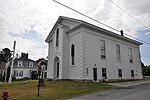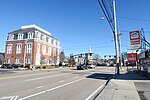Algonquin Regional High School

Algonquin Regional High School is a public high school located in Northborough, Massachusetts, United States. The school serves the students of the Northborough-Southborough Regional School District (NSRSD) comprising both Northborough and neighboring Southborough. The school's mascot, as of February 11, 2022, is the Titan. The former mascot was the Tomahawk, known by many as the "T-Hawk." On April 28, 2021, the Northborough-Southborough Regional School Committee voted, 9-0, to retire the Tomahawk as its mascot. A study group was assembled to determine a new mascot, which was voted on by the student body at that time. The school's colors are maroon and gold. Algonquin Regional's Superintendent is Greg Martineau and its Principal is Sean Bevan.
Excerpt from the Wikipedia article Algonquin Regional High School (License: CC BY-SA 3.0, Authors, Images).Algonquin Regional High School
Bartlett Street,
Geographical coordinates (GPS) Address Nearby Places Show on map
Geographical coordinates (GPS)
| Latitude | Longitude |
|---|---|
| N 42.325833333333 ° | E -71.613333333333 ° |
Address
Bartlett Street 79
01581
Massachusetts, United States
Open on Google Maps










